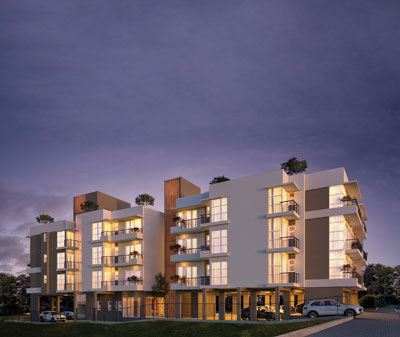No slowdown in apartments in Colombo-report
View(s):There has been an increase in the number of apartment projects in Colombo and Greater Colombo areas, according to data compiled by leading property website LankaPropertyWeb.com.

Seen here is a design of the proposed ‘Aurora Residencies’ being constructed by Global Housing & Real Estate (Pvt) Ltd at Battaramulla.
Based on the certifications issued for Condominiums, Semi Condominiums and Provisional Condominiums by the Condominium Management Authority (CMA), the number of certificates issued has increased specially within Colombo city during the last three years and in the first nine months of 2017. It has exceeded last year’s total number of units, the property web company said in a media release.
A significant decline can be observed in other parts of the countries this year so far, which shows that developers are still focusing on Colombo and its suburbs for new developments despite some new developments being launched in Kandy, Galle, Wattala and Negombo.
The average floor area in Colombo has been 120 to 135 square metres in 2015. There had been relatively a large number of condominiums approved and constructed with lesser floor areas in 2015. As a result, the average floor area was recorded as 85 square metres, the release said.
The average floor area of the condominiums in Greater Colombo area is in the range of 100 to 125 square metres through the studied period and it looks stable than in the Colombo area. The average floor area of condominiums in all the other districts range from 40 to 110 square metres.
Preliminary planning clearances have been issued to more than 3000 units in Colombo and more than 2000 in greater Colombo. The annual average clearance issued for Colombo was 1600 from 2014 to 2017. The greater Colombo average was 1000 and other districts 450. But in the last two years the average of clearances issued within Colombo has risen to 2100 and greater Colombo and other districts remained at same levels.
Bambalapitiya, Wellawatte and Colombo 7 see huge increase
Colombo 6 has been the most crowded area for condominiums as per the data for the period from 2014 to 2017. Colombo 6, Colombo 13, Colombo 9 and Colombo 3 are the areas with the highest number of units given approval by the Condominium Authority during this period. Lowest level of such approvals was obtained in Colombo 1, 10, 11, 12 where most of the areas have been occupied by either commercial or administrative establishments.
“Interestingly more condominium constructions were given Preliminary Planning Clearance in areas such as Colombo 4, 7 and 6 as at August 2017. This would mean that areas such as Colombo 4 and 7 are expected to see many new apartments for sale coming up within the next few years, compared to the level of condominiums that was built up during the last three years,” the release said.
| Land prices index The North Central Province, according to the Land Affordability Index (LAISL) compiled by the leading property website LankaPropertyWeb.com which compares the land prices of a province against the average earnings of the residents in that province, is the most affordable for its residents, while not surprisingly Colombo is the least affordable. On the house affordability conducted within the Colombo district, Hanwella DS came up as the most affordable for a 2-bed house while Padukka came up as the most affordable for above a 2-bed house. The LAISL provides an average Sri Lankan’s ability to purchase a plot of land (7 perches) based on the median income of a given year. The affordability changes based on household income level in different regions and interest rate of the country, the property web said in a media release. The recent land price data collected indicates that the average Sri Lankan cannot afford to buy a plot of land in any of the provinces, generally where they live. The most affordable province to buy a plot of land is the North Central whereas Colombo seems to be too expensive for an average Sri Lankan. Sabaragamuwa and Uva are the next best available areas that an average Sri Lankan can afford. Purchasing a land plot from North Central, Sabaragamuwa and Uva is four times affordable than purchasing a plot from the Western Province. The highest 10 per cent income-earning householders are able to purchase any land plot in the country except the Western Province. Level of affordability has increased significantly in the North Central province in 2017 than in 2016, but only exception was observed from the Eastern province, where the price level has declined compared to other provinces, the release added. House affordability in Colombo It was found that affordability of purchasing a house with two bedrooms in Colombo city is the least possible for an average Sri Lankan and purchasing from Hanwella area is the most affordable. The affordability of purchasing a house is easier in Padukka than any other place in the Colombo district for an average Sri Lankan. Purchasing a house within the Colombo city, Sri Jayewardenepura Kotte and Dehiwala is less affordable compared to other areas in Colombo district. Further, an average Sri Lankan’s ability to purchase a house is 13 times greater in Padukka than in Colombo city. The highest 10 per cent income earners have three times greater affordability over Colombo average householders to purchase a house with more than 2 bedrooms and also 2 1/2 times the ability to purchase a two bedroomed apartment from Colombo city area. Housing loans easing? The loan and advancers offered by commercial banks to private sector for purchasing houses, new construction and repairs has grown on absolute terms, but the growth has been in the declining trend especially after the last quarter of 2015. The last quarter of 2016, suggests that credit to housing has started growing up again. But the year on year growth has been on average 30 per cent from 2015 onwards. This is significantly high credit growth comparing with other industry sector. | |


